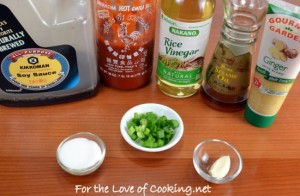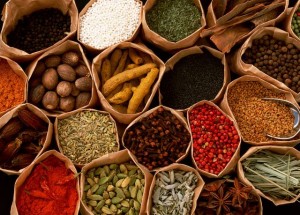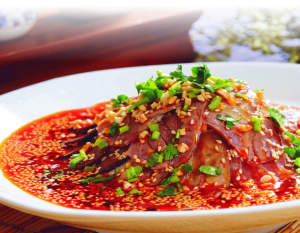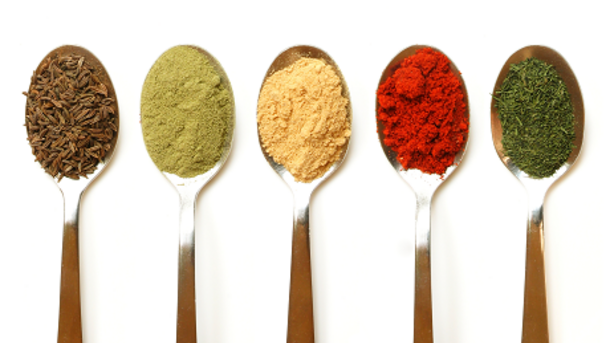By: Amelia Chen
For awhile, Jeff Porter’s Cooking for Geeks was my bible of sorts – a great introduction to food science if you’re entering from the side of the kitchen. He did an interview with Gail Vance Civille in the chapter about flavor that caught my attention:
“If you have a classically trained French or Italian chef, they can create something where I will be scratching my head…because it’s so tight, it’s so blended, that I can’t see the pieces. I only see the whole. Now this does not happen with a lot of Asian foods, because they are designed to be spiky and pop … Asian foods have green onions, garlic, soy, and ginger, and they’re supposed to pop, pop, pop.”

Essential basic ingredients for Asian cooking. Courtesy of fortheloveofcooking.net
Civille had put in words something I’ve always been acutely aware of about the differences between the food my parents prepared at home and the food we ordered at certain restaurants. Reading that didn’t necessarily change how I viewed food or cuisine, but it came to mind whenever I was tinkering with a new recipe. I always wanted to really taste every ingredient I used. (This is probably why I would be a terrible sensory panelist, by the way). And I adjusted based on what – sweet, salty, sour, bitter, umami – seemed to be blatantly missing.
It was fitting that I watched The Hundred Foot Journey on a plane to France, then. The argument between Madame Mallory and Papa echoed a similar idea:

Basic Tastes: Sweet, Sour, Salt, Umami and Bitter Image courtesy of treatology.wilton.com
Papa: You seduced his mind with your awful, tasteless, empty sauces! With your pitiful little squashed bits of garlic!
Madame: That is called subtlety of flavor.
Papa: It’s called meanness of spirit! If you have spice, use it! Don’t sprinkle it. Spoon it in!
Madame: What you do not seem to understand is that there is such a thing as enough. Enough is a enough arretez!
I’m going to have to side with Papa. Don’t hold back on the garlic. But I wholly appreciate both styles of cooking. Sometimes you need pop, and sometimes you need balance.

A range of spices often used in Indian cooking
My friend had sent me an article titled, “Scientists have figured out what makes Indian food so delicious.” Ignoring the fact that “deliciousness cannot possibly be a scientific measurement, the article was interesting because it investigated a couple thousand recipes to find that “Indian cuisine tended to mix ingredients whose flavors don’t overlap at all,” which contrasted Western cuisines, concluding that “part of what makes Indian food so appealing is the way flavors rub up against each other.”
Acknowledgement of these cultural cooking differences is not satisfying enough though. I wanted to know why.
My dad has taken me back to China a few times, I’ve started noting the regional differences in food. I always knew the drier, cooler north favored flour whereas the hot and humid south was big on rice. In just one of those trips, we had sampled a variety of famous dishes from the Dongpo pork of Hangzhou to the liang pi noodles of Shaanxi to my favorite “husband and wife lung slices” appetizer of Sichuan. If you’ve ever tried any of these things, you’d know that they certainly aren’t lacking in “pop.” Chinese cooking reflects yin and yang philosophy. That is, opposite forces are complementary. You might already be familiar with this as many Chinese restaurants are built on sweet and salty, sweet and sour, as well as pungent and salty meals. The opposing tastes compete for your attention without overpowering each other, so each bite seems to be different.

The dish “husband and wife lung slices”
A less obvious philosophy seems to exist for French food besides that only the freshest, local ingredients should be used and highlighted. It goes to follow, then, that chefs would aim to blend the supporting flavors, so the delicate ingredients are not lost. As just one example, I think Thomas Keller of The French Laundry and his philosophy of “the law of diminishing returns” sums up Civille and Madame Mallory’s sentiments well. He says, “palate fatigue is certainly aligned with the law of diminishing returns, and once you’ve reached a point where your palate is satiated, then the flavors, no matter how impactful they were in the beginning, are going to peak.” This reminded me of my favorite, and incredibly simple, meal in Paris – scrambled eggs with sundried tomato and goat cheese. The scrambled eggs, serving as a blank canvas, were supported by the accompaniments, which were both predominantly salty and tart, but not so much so that you lose sight of the eggs.

French onion soup a quintessential example of french cuisine. Image courtesy of seriouseats.com
Where flavor preference in cuisine originates is a tough question to answer, if at all, I’ve found while researching for this post. I had theories, including religious beliefs and what plants are native to each country. Though I was unable to come to a solid conclusion about the birth of cuisine, it’s obvious to me that both Chinese and French food philosophies have and continue to influence many other types of cuisine, as well as each other. Following the evolution and adaptation of ingredients and cooking styles, it seems the next “steps” of “fusion” cuisine is a balance of the Western and Eastern ideas of balance.
References
Ferdman, R.A. (3 March 2015). Scientists have figured out what makes Indian food so delicious. Retrieved 8 September 2015, from: http://www.washingtonpost.com/news/wonkblog/wp/2015/03/03/a-scientific-explanation-of-what-makes-indian-food-so-delicious/
Iannolo, J. (2006). Thomas Keller: A philosophy of respect. Retrieved 8 September 2015, from: http://gildedfork.com/thomas-keller/
Parkinson, R. (2015). Ying and Yang in Chinese Cooking. Retrieved 8 September 2015, from:
http://chinesefood.about.com/library/weekly/aa101899.htm
Potter, J. (2010). Cooking for Geeks. Sebastopol, CA: O’Reilly Media, Inc.






Leave a Reply